PERAZZI -PASSION, PRIDE, PERFECTION BY GARY PRZIBILLA
Photography by Leigh and Gary Przibilla
Page 56. „Game Models 28 Gauge.“ I was mesmerized by the five exquisite, miniature guns … Perazzi MX28. The die is cast.
I had long considered the purchase of my fine game guns. I wanted two over and under shotguns, not a pair. My original intention was to order a portfolio gun – an investment gun – and an additional fine gun which could be used with care but without undue worry. For O/U guns, „all roads led to Rome“ … northern Italy, at least. The Perazzi factory nestles in picturesque Botticino Mattina, near Brescia. Armi Perazzi S.p.a. is directed by Mauro and Roberta Perazzi, son and daughter of the firm’s beloved founder, Daniele Perazzi, who sadly passed away in late 2012.
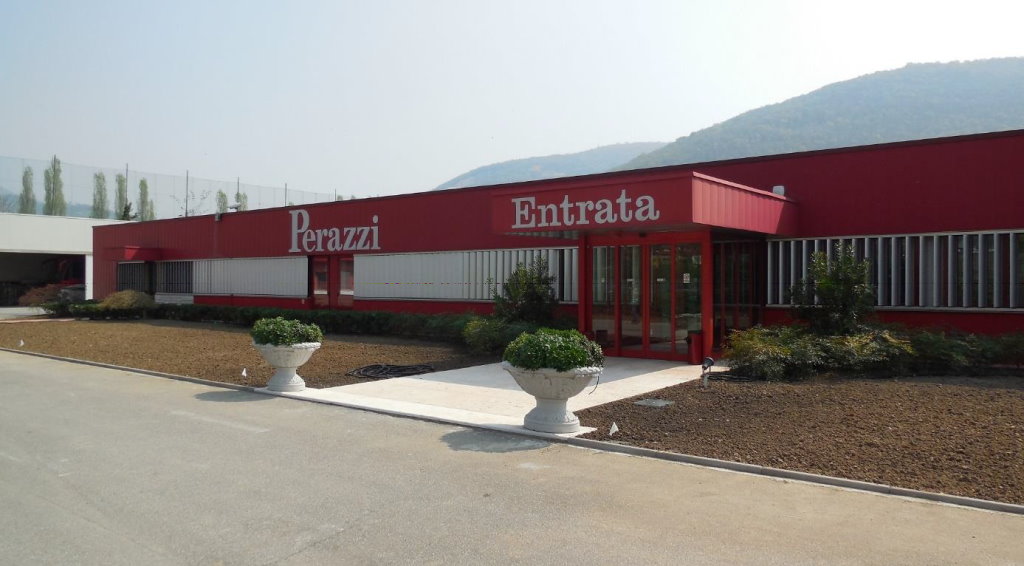
Perazzi factory entrance.
My friend, Pavel Zeman, had collected the 132-page catalogue (more so a high quality book) from the Perazzi display at the IWA Outdoor Classics Exhibition in Nuremberg, Germany. For a touch of irony, I’ll add that Pavel was a sales executive for the former Zbrojovka Brno. The complete catalogue can be viewed on the Perazzi website: www.perazzi.it
June, 2012. I telephoned Italy. Bianca Revello, Perazzi’s Sales Manager, took my call. During the next half-hour, or there abouts, I learned more about what makes a Perazzi shotgun tick than I had hitherto in my entire life. Right down to the type of solder used to attach the side ribs – and why – Bianca knows her guns. Later, I invoked my investment gun. Bianca had rolled out the red carpet well beforehand. I rang off feeling good about Perazzi.
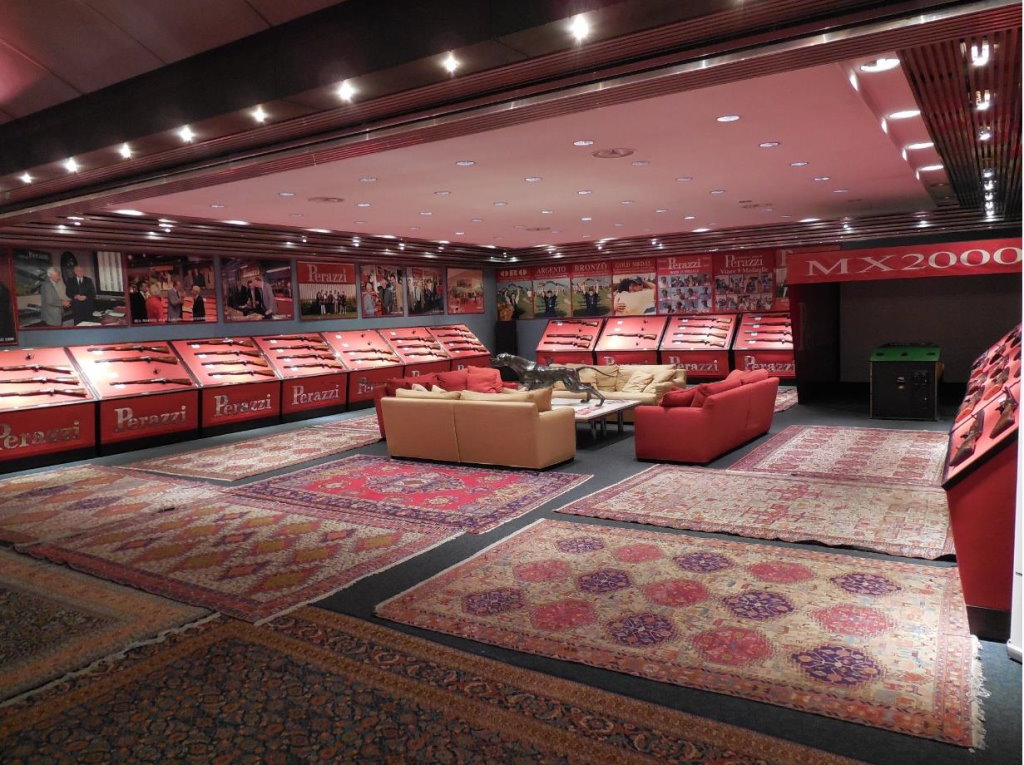
Showroom. Fabulous.
The well-oiled machine clicked into gear. Bianca had contacted Filippo Petriella, Perazzi Australia’s Managing Director. Filippo’s care, knowledge, and patience rivalled Bianca’s. I ordered two guns: MX28 and MX28 SCO/Gold Sideplates. In Italy, the latter model is known as MX28 SCO/Oro Cartelle, and „MX28 SCO/OC“ is stamped inside the gun. SCO means Sovrapposto (over/under) Competizione (Competition) Oro (Gold). „Oro“ – in this context – identifies the gold wash plating which protects the SCO and higher grade guns‘ highly polished firing mechanisms from corrosion. Perazzi Australia can be contacted at www.perazzi.com.au
Perazzi O/U frames (receivers) are scaled for 12, 20, 28 and .410 gauge shotshells. 28 gauge guns can be ordered on the larger 20 gauge frame. The Very Small Frame MX28 (and MX410) guns were introduced in 1993 and, at this writing (2013), Mauro Perazzi estimated that approximately 350-400 pieces had been manufactured. The MX28 frame is 52 mm deep, and the MX410, 50 mm … that’s finesse. Limited production and scaled-down elegance has its price: When I visited the Perazzi factory in April 2013, MX28 retailed for EUR 16,243. An elaborately engraved 20 gauge gun – MX8/20 in SC3 grade – had a slightly lower price ticket. MX28s and MX410s come with SCO grade deluxe walnut stocks and SC2 (pattern No. 101) engraving. Even so, aficionados of Perazzi’s Very Small Frame guns must have noted the price differential (not discrepancy). A new model – MX28B – was brewing … .
MX28 and MX410 are miniature versions of the Perazzi MX12, introduced in 1987 (single selective, non-detachable trigger system with coilsprings). MX8 is the unrivalled competition gun, designed for the 1968Olympic Games in Mexico City (single selective, detachable trigger mechanism with flat springs; coil springs are optional). MX8 and MX12frames are shaped alike and share many parts. Both have the famed Perazzi jointing and bolting, inspired by the Boss and Woodward guns. Larger bearing surfaces favour the Perazzi; appropriate for a high shotvolume competition gun.
Mexico ’68 was abridged to name the MX8. Other Olympians were MT6 (Montreal ’76) and MS80 (Moscow ’80). MX prevailed, and became synonymous with the famous Perazzi marque; so too has the company colour scheme – Italian racing red – which reflects its competition pedigree. MXS has just been announced.
For the Sideplates gun, and with Mauro Perazzi’s guidance, I specified 72 cm length (283/8 inches) barrels with a flat, parallel, 7 X 7 mm rib; 70 mm (2 3/4inch) chambers; fixed chokes of 4 and 8/10 mm constriction (English coding 1/4 and 3/4); solid side ribs which were optional, and a game sight. Catalogued barrel lengths were 68, 70, 72 and 75 cm. Interchangeable chokes could be ordered, but on a fine, game shotgun I preferred the fixed ones. I ordered the frame and parts – trigger guard, fore-end iron and top lever – to be finished white. Blued or nickeled frames were optional. A pierced (skeletonized) top lever completed the metal options. MX28 was specified identically, and consecutive serialnumbers were allotted.
Perazzi gunstock wood is graded according to commonsense (… seemingly lacking in some walnut houses). The seven walnut grades – Standard, MX2000, SC2, SC3, SCO, SCO/Sideplates and Extra – reflect the guns‘ models. Of course, there are exceptions to the rule. As noted, MX28s have SCO-grade stocks, and any gun can be ordered with upgraded wood. I ordered SCO/Sideplates and Extra grade. The gunstocks‘ specifications would be decided later … on location.
If ever you order a fine gun, never skimp on the timber. Furthermore, an astute decision now could, one day, pay you back handsomely. Great walnut befits a fine gun, and only the finest guns should be engraved. Admittedly, the better grades of walnut are very expensive; nevertheless, the additional cost pales into insignificance when compared with the price of master engraving. Although the wood cannot possibly outshine the artwork, investing in high grade walnut is something you’ll never regret. I have just described the shrewd collectors‘ pragmatic approach. If you can’t justify the commissioning of an elaborate engraving pattern, or simply prefer plainer guns, yous hould at the very least consider buying the better walnut.
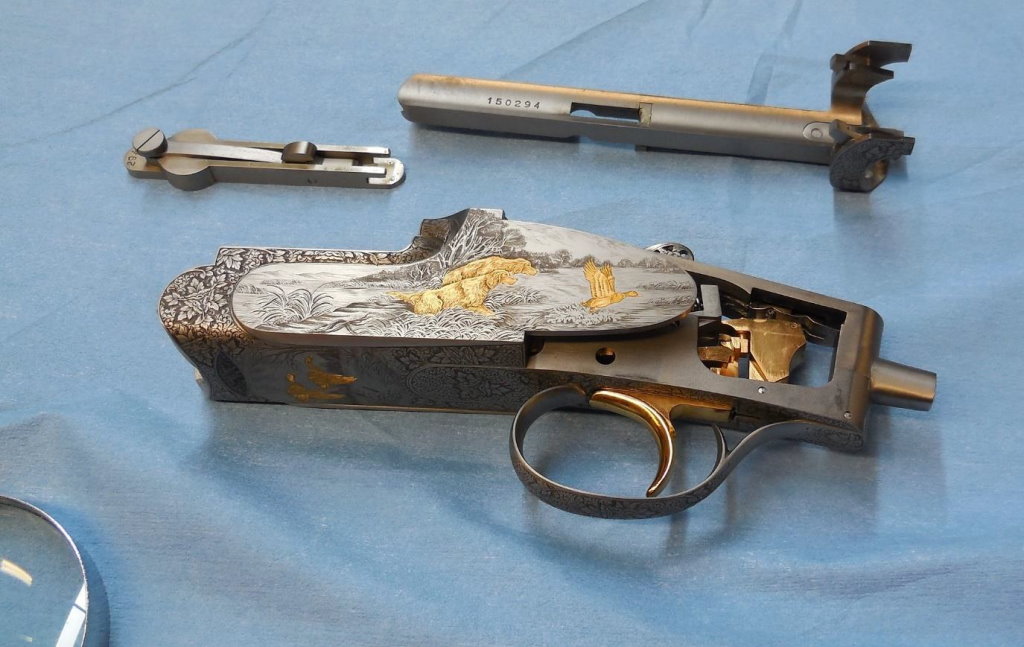
My first viewing of the MX28 SCO/Gold Sideplates (MX28 SCO/OC) gun. Pattern No. 341 engraving by Creative Art.
I have carefully penned the words, „better walnut.“ Beautifully coloured and strongly grained (structurally) stock wood is practical for a using gun. Fabulous Extra grade, exhibition walnut isn’t. Overdoing the wood can overwhelm an understated gun. In „Perazzi Shotguns“ (1994), Karl C. Lippard described how AAAAAA (6A) walnut blanks can be dangerous to even cut for a gunstock. A straight-grained, slim wrist is already fragile; one exploding with colour and multi-directional grain is fraught. Exhibition walnut is de rigueur for guns which are intended to be exhibited, and seldom (if ever) shot. In the context of this article, Mr. Lippard’s 6A is Perazzi’s Extra grade. His words were prophetic: I have personally „remodelled“ a magnificent walnut rifle stock into a two-piece one. The gunstock has since been repaired at great effort by the original maker (which is what you do with rare exhibition wood). Nevertheless, Extra grade walnut was mandatory for my portfolio gun (MX28 SCO/OC), and MX28 was my insurance policy.
Over three decades, I had learned to personally select my walnut blanks. Photographs are good, sometimes necessary, but are nowhere near as informative as holding the wood in your hands, turning it and watching how the light affects the colour, contrast … . I had no need nor desire to pore over photos. Italy beckoned. Perazzi’s fabulous showroom, and others with rows and rows of Turkish walnut. Venice. Rome.
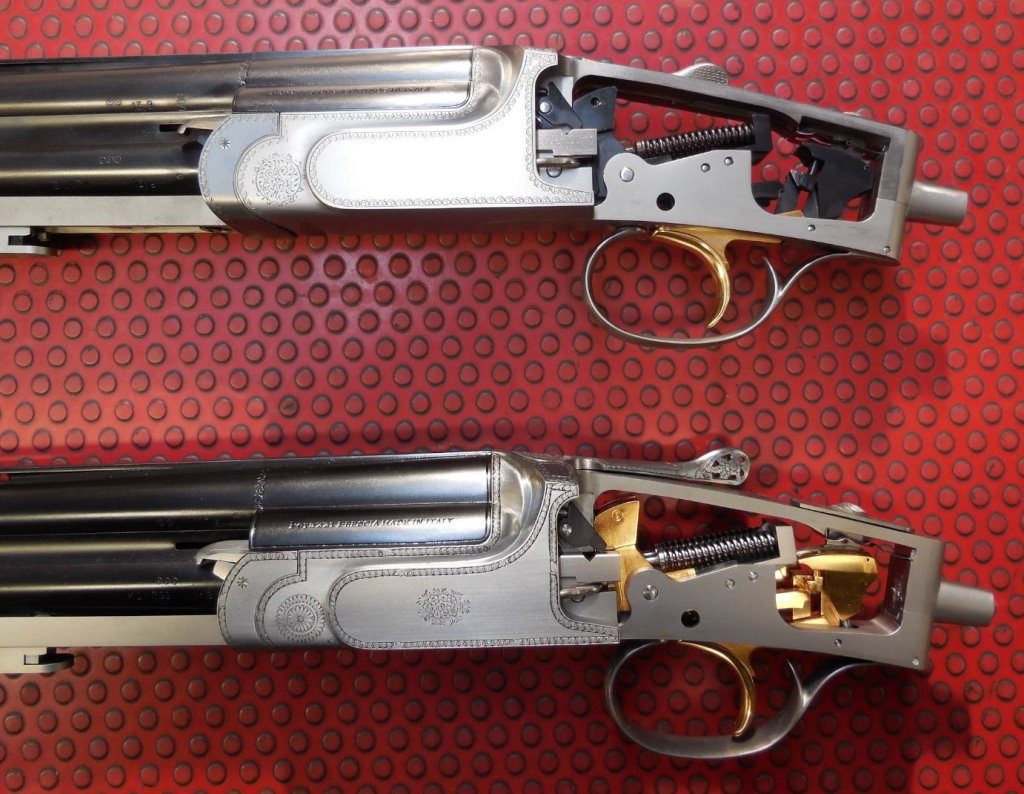
Lovely MX28B (top). One-of-a-kind MX28 has SCO gold-plated lock components and minimalist engraving by Creative Art.
Mauro Perazzi had written me a letter: „… I would like to thank you also for the order of your guns. I will personally take care of their production. I really hope to meet you in our factory for wood selection and gun fitting … together, we will select special wood for your shotguns.“ What more could I have even wished for? My guns were in the very best of hands.
I had taken delivery of my very first custom rifle in 1979. I was 23 years old, and thought I knew everything. The gun was a glitzy, engraved model from a famous Los Angeles manufacturer. I was smitten, and ordered another. In 1981, I visited the factory. Rifle No. 2 was progressing well. I browsed the factory gun display and learned a poignant lesson about engraving. The great man’s personal guns were elaborately engraved, but not like mine, or those depicted in the catalogue. The penny dropped. I had seen good engraving. Proper engraving. My disappointment matured over the years and, unlike a well-aged Chivas Regal, didn’t improve. I eventually sold the guns. I would still have them had they not been engraved. In 2013, Perazzi and Creative Art quietly laid my 32-year-old engraving ghost to rest.
Importantly, and in particular for an investment grade gun, the Perazzi catalogue states: „From the standard models to the deluxe versions, each engraving – from the simplest to the most sophisticated – is undertaken by internationally renowned, master engravers, to satisfy the individual tastes and style preferences of each of our clients. All engraving is done by hand, not by machine or laser.“
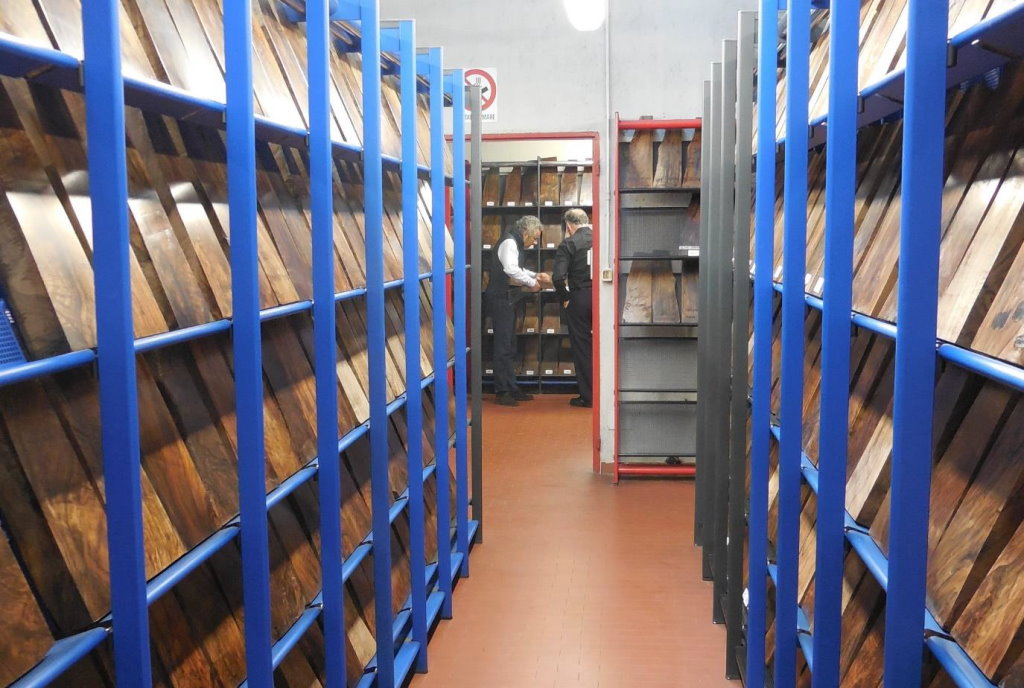
Rows and rows of exquisite Turkish walnut blanks.
On many of the pictured engravings, and if you’ve got an eagle eye, the engravers‘ signatures can be identified, including: Badillini, Bonsi, Campana, Cortini, Creative Art, Galeazzi, Pedersoli, Terri and Zacchi. Perazzi commissions other master engravers. I had the unexpected privilege of meeting the quietly spoken Dassa brothers. You need to see their masterpieces, which cannot be described in words. Incisioni Dassa Workshop: www.incisionidassa.com
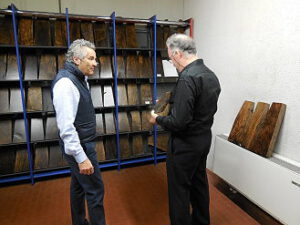
Mauro Perazzi and Gary Przibilla selecting SCO/Sideplates grade walnut.
I’m attracted to game scenes. And gold. In about 1976, gun shop proprietor Barry McDonald imported a gold-inlaid Merkel O/U shotgun. I was 19 or 20 when Barry showed me the gun which I would never forget. Nor his words: „I had to send my own gold!“ Exportation of the precious metal was prohibited by East Germany. A friend dusted off some photographs (one, a Polaroid). I remembered the golden game animals and deep relief engraving.
Fine scrollwork adorned the frame, breech and upper barrel. Unfortunately (with the crystal clear vision of hindsight), I hadn’t noticed. I was bedazzled by the glitter.
I admired engraving pattern Nos. 341 (left side), 342 (right), and 313 (under) on page 76. The artist wasn’t identified. Although it’s not apparent in the catalogue, Bianca Revello had earlier informed me that the game animals on the SCO, SCO/Sideplates and Extra grade guns can be ordered gold inlaid. I was also very attracted to what I call the „minimalist“ engraving pattern (101) on the SC2 grade guns. Pattern No. 101 (pages 50 and 51) is the standard MX28 engraving, and is the perfect example of simple elegance, where less can indeed be more. Over many weeks, I had habitually returned to page 76 for the SCO/Sideplates patterns. The decision was made. Almost … .
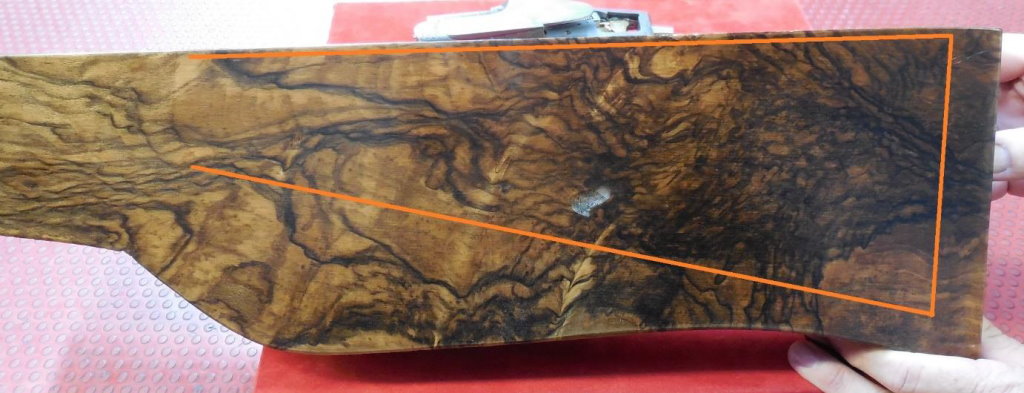
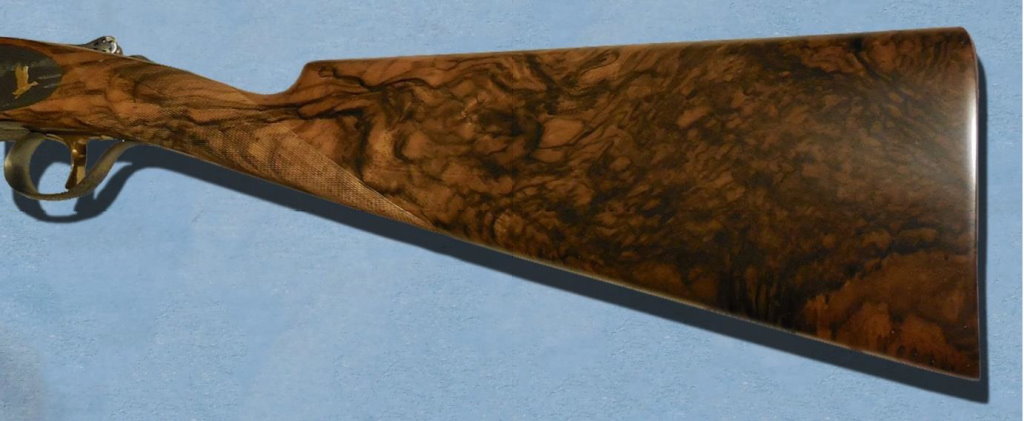
Extra grade walnut selected for MX28 SCO/OC. About half of the wood ends up on the workshop floor
… a most important consideration when evaluating the walnut blank.
I had spied the higher contrast border engraving (the so-called Rose and Scrolls) on the gun pictured on page 77. The gun was engraved by Creative Art. Now things were becoming tricky; I preferred the game scenes on one gun, and the border engraving on another. Just how finicky a client could the Perazzi people bear? The answer, dear readers, can be found in this story’s title.
The guild of Italian master engravers, Creative Art, was established by Giacomo Fausti and Ugo Talenti in 1987. Giacomo Fausti and Mauro Perazzi are longtime friends, and it transpired that Creative Art would engrave both guns – MX28 SCO/Gold Sideplates and MX28 (SC2). Creative Art’s list of clientelle includes Armi Perazzi S.p.a., Fabbri s.n.c., Holland & Holland, James Purdey & Sons Ltd, A. Galazan, et al. Creative Art: www.creativeart.it
I learned much about engraving. I had seen very similar scrolls and scenes on other makers‘ guns, and by other master engravers. My most valuable lesson learned is an appreciation of how well the particular engraving is executed and, of course, who did the work. Two engraving scenes might at first look the same. Other shotguns might look like Perazzis. Like the guns, there is no budget engraving on a Perazzi. Less sophisticated patterns depending upon the model, yes. Lower quality, no.
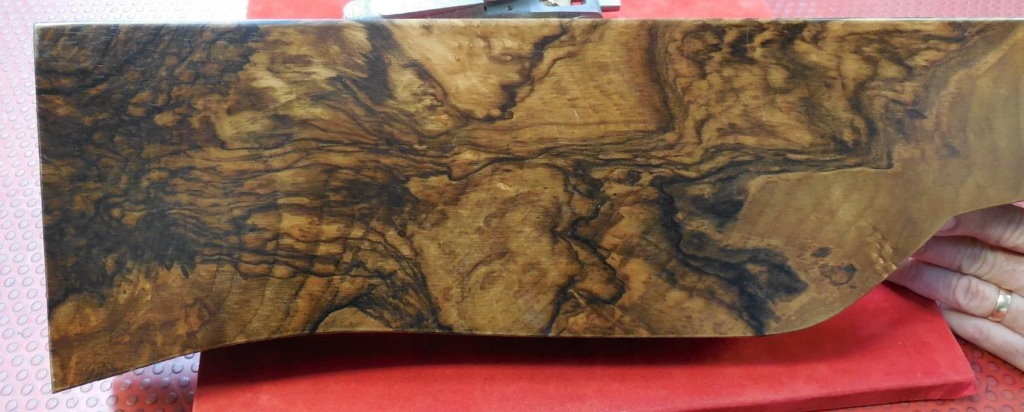
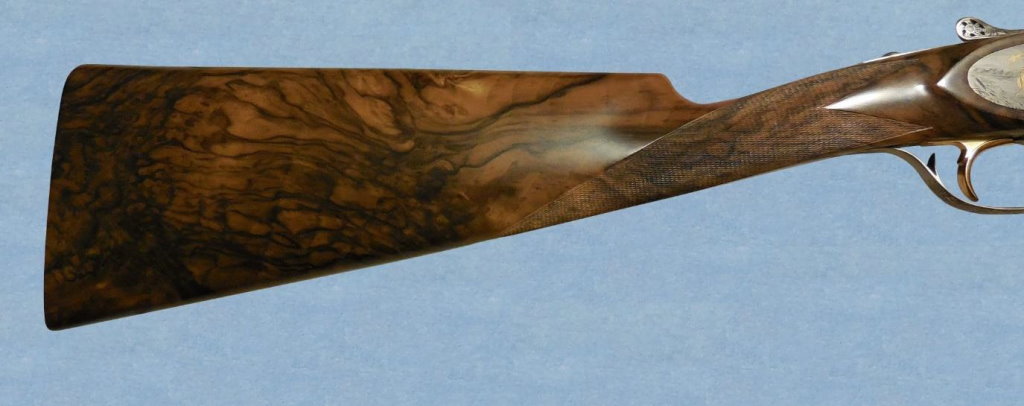
Extra grade Turkish walnut blank and the completed stock. Mauro Perazzi plotted the perfect layout.
MX28 was becoming problematical, and a very good one to have! Creative Art engraves only the Perazzi SCO and higher-grade guns. My „using“ gun was becoming collectible. Unique.
In the interim, I had compounded the mess by upgrading the firing mechanism to SCO grade (gold plated lock components). When Mauro Perazzi proudly handed me the gun, he said, „It’s the only one we’ve ever built that way.“
During a late night telephonecall to Steve Fjestad (Blue Book Publications, Inc.), I mentioned that Creative Art were engraving both guns. Steve knows more than a little about Gun Values, and he suggested that it would be advantageous if Creative would also sign MX28. He also remarked, „You certainly picked the right gauge!“ I telephoned Mauro Perazzi. Creative Art signed both guns. They would have, anyway, but it was good to check. I also mentioned my dilemma.
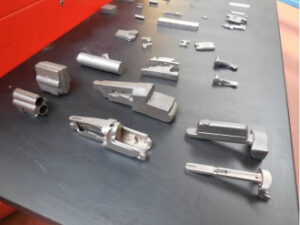
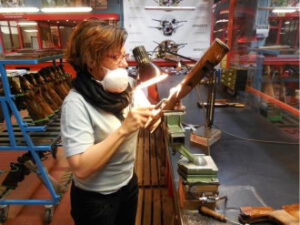
My timing for the telephone call wasn’t exactly perfect. It was the evening before the Perazzi factory – and much of Italy – closed for the summer holidays. Mauro Perazzi was about to depart for the London Olympic Games, where Perazzi shooters won 12 of the 15 shotgun competition medals. Perazzi knows how to build an O/U shotgun! I apologised, but Mauro insisted we chat. Mauro mentioned the new model – MX28B (Basic) -which was introduced in 2012 to provide a Perazzi Very Small Frame gun at as low a price as possible. MX410B also joined the ranks.
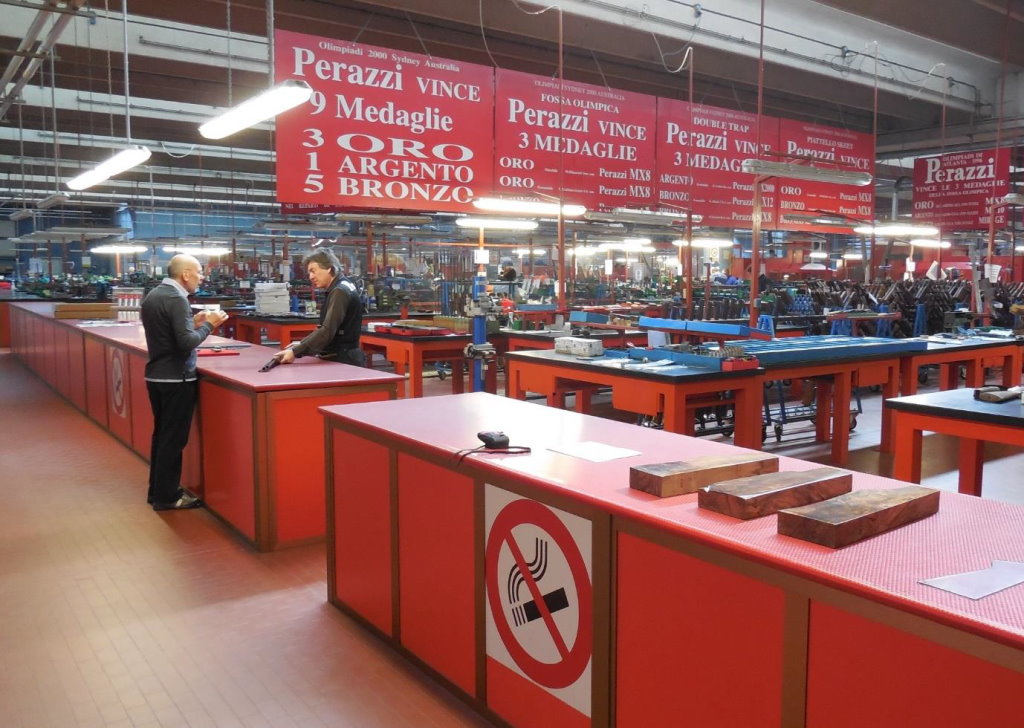
Fabrizio Salvini, the Customization and Service Manager, attending to a customer. That’s how it is at
Perazzi. Open factory. Direct contact. My walnut blanks are in the foreground.
In Europe, and at this writing, MX28B retailed for approximately 40% less than MX28. Mauro Perazzi explained that the savings were achieved by applying a less ornate engraving pattern, well figured walnut for the stock and fore-end, and less time spent on finely polishing the parts. When I closely examined a dismantled MX28B, I noted the domed and finely polished ends of the lock dowel pins, parts which rarely see the light of day. The engraving was signed by „Terri,“ a specialist in fine English scroll. The lady’s signature can also be seen on the beautiful case colour hardened SCO/Sideplates gun which is pictured on page 132 of the catalogue. MX28Bs are fine guns. MX28B … Bella!
Later, I wrote to Mauro concerning Perazzi shotguns in general. I had coined the terminology, „raw shotguns.“ Mauro’s reply slots very nicely into this article: „The raw shotguns are the same, we use the same steel for all our models, and the same production methods. What makes the difference between a standard and an upgraded model is the embellishment of it, for example, the side plates, engravings, special selection of the wood, and of course the many, many hours we take to finish the gun (polishing of the parts, the blueing, etc., etc.)“ I had assumed as much, but it’s good information concerning the steel and production methods.
We talked for a long time. I learned that the 28 gauge is gaining in popularity. Mauro Perazzi’s favourite game gun is a 28 gauge. He had just given his original gun to his son, and now had another. „A Baikal!“ I told my friends. I was quietly pleased about Mauro’s favouring the 28 gauge (except for the larger birds, or game shot at longer distances), and I remembered Steve Fjestad’s words.
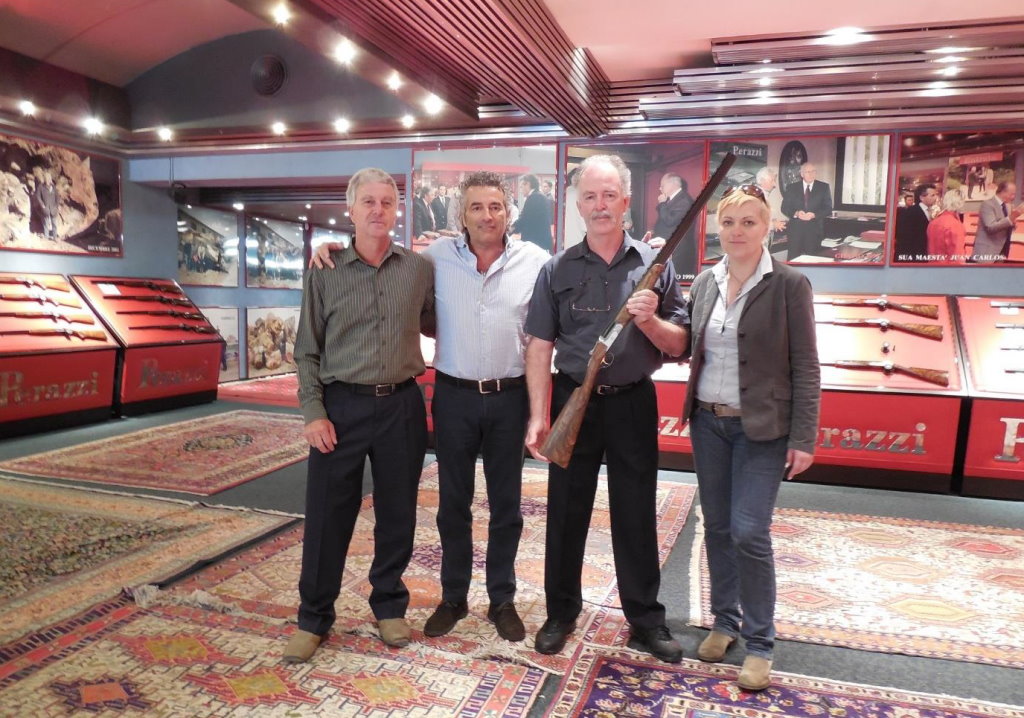
Leigh Przibilla, Mauro Perazzi, Gary Przibilla and Bianca Revello. (Roberta Perazzi photo.)
Six weeks passed. I ordered MX28B. By now, Mauro Perazzi knew my Achilles‘ heel, and added SCO/Sideplates wood. Everything else, including the white parts finish, is factory standard MX28B. Almost as an afterthought, I inquired as to the availability of the third consecutive serial number. No matter if it weren’t. Serial numbers are closely regulated by the government, and can’t be conjured up for convenience. Mauro had pigeon-holed the number before he’d left for London! I had run out of things to do. Only the waiting remained … .

The following afternoon. MX28 was waiting, stocked to the finely-sanded stage, and ready for a tryout on the test-pattern plate.
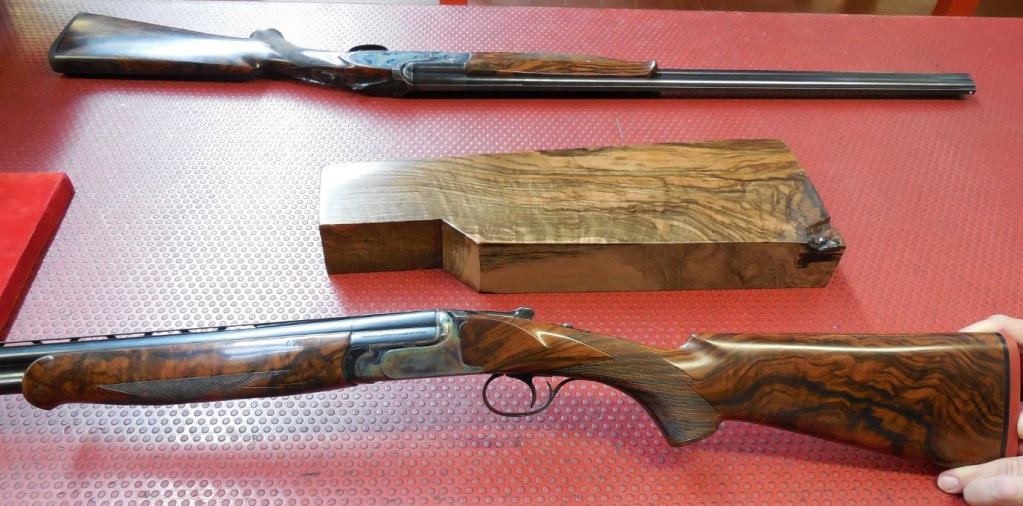
Mauro Perazzi’s new MX28 SCO/Sideplates gun (top), and his former MX28, which now belongs to his son. SCO/Sideplates grade Turkish walnut blank was chosen for MX28 (see previous photo).
November, 2012. News. The shotguns had been serialized. Mauro added, „The three barrels are ready, and now we are going to start the assembly of all mechanical components.“ In December, Perazzi delivered the two receivers to Creative Art.
March, 2013. Mauro wrote, „I have good news for you … The two MX28s are ready and the SCO/Sideplates will be ready in 3-4 weeks. Creative Art did an excellent job! It is time to plan your trip to Italy.“ My brother, Leigh, decided to sample Italy; particularly Rome. We booked the plane.
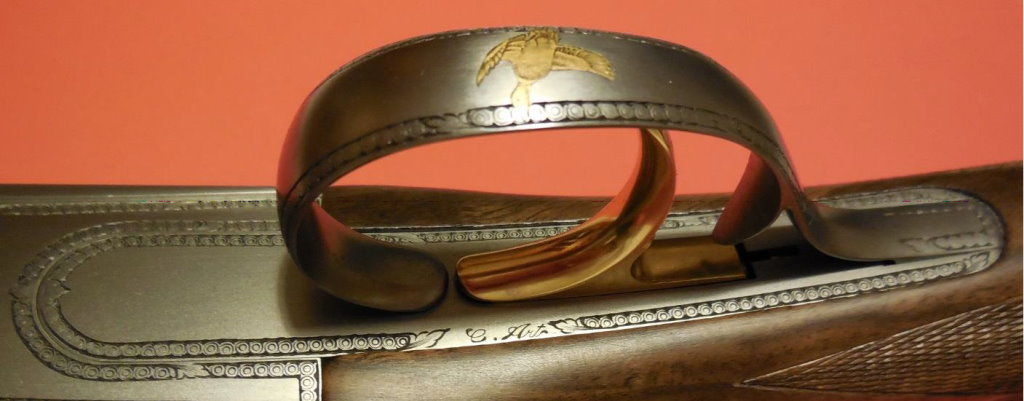
Creative Art had signed the MX28.
April 2013. Steve Fjestad had told me about the Exa Expo, outdoor sports and activities show which is held annually in Brescia. Mauro Perazzi and Bianca Revello were busily entertaining their guests and the many passers-by who were admiring the fabulous Perazzi gun display. Nevertheless, we were instantly recognized, greeted warmly, and immediately made to feel at home. A sideplated gun with a mallard game scene in gold and enamels caught my eye. Mauro said that the engravers – Incisioni Dassa Workshop – have a display booth just around the corner. I disappeared around there for a little while. If you’re in Brescia in April, don’t miss the Exa. Two days later, Andrew (our driver) dropped us outside the red gates.
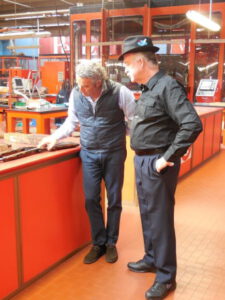
Admiring the Perazzis’ personal MX28s.
Through the automated entrance doors, and we were greeted at the reception desk. We waited briefly in the fabulous Perazzi showroom which contains examples of the principal hunting and competition models and a Perazzi competitors‘ Hall of Fame. The lounge suites were extremely comfortable and showed little to no wear. Perhaps that’s because the guns displayed around the showroom’s perimeter can be both viewed and handled by the clients. We’d spend considerable time here, later, and also visit „Perazzi Style,“ the new clothing and accessories showroom.
Onto the factory floor. Mauro Perazzi introduced us to Fabrizio Salvini, the Service, and Customization Manager. My guns‘ barrels and frames were already laid out for viewing. I admired them briefly while Fabrizioattended to a customer. That’s how it is at Perazzi. Open factory.
Direct contact. Customers and even interested passers-by can drop in for a visit, admire the many fine guns on display, and observe others taking shape behind the benches. Brilliant. Concerning the barrels and action components, everything had exceeded my expectations. MX28’s golden lockwork gleamed. Mauro hadn’t „gilded the lily“ when he wrote about Creative Art’s engraving; if anything, he had left room for wonder. And I didn’t have to bring my own gold.
Mauro produced the 20 gauge try-gun, consulted with Fabrizio as I shouldered the gun, and the duo made a few quick adjustments to the gunstock. No tape. I was sized-up by experienced specialists. Results on the automated – for both distance and target rotation – pattern plates confirmed that the try-gun was a near-perfect fit. A few more fine adjustments finalized my stock specifications. Returning the gun to its rack, Mauro said that I’d just shot the same gun as did the King of Spain!
„We’re going to select two stock blanks from this room [SCO/Sideplates], and one from in there [Extra],“ said Mauro. I need not have worried about being able to find superb walnut at Perazzi. The walnut blanks come from far east Turkey, near the Iran and Iraq border, and Perazzi’s collection is extensive. Wonderfully so. We swapped ideas and, together, admired many exquisite blanks. After more than a little while, I said to Mauro, „It’s not working. I’m becoming more confused by the minute. I’m going to have to invoke my own rule.“ Over many years, I had given much advice to prospective walnut buyers. One of the most valuable lessons learnt is that it is indeed possible to see too much great walnut at once. I revisited the five or six walnut blanks which had first caught my attention. From those, I selected my three beauties.
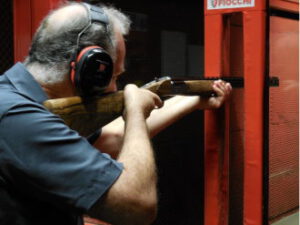
My very first shots with the MX28
Mauro showed me his son’s MX28, and his own new one, a sideplated gun. And no, it wasn’t a Baikal! The Perazzis‘ personal MX28s have the interchangeable chokes, so if you decide to order a gun with them (instead of the fixed chokes) it’s fine by me. I hadn’t asked Mauro to show me the family 28s, but he had remembered our telephone conversation. I noted the two beautiful guns had the schnabel (beak)fore-ends, and ordered the same. This little detail wasn’t apparent in the catalogue, but I had seen the various buttstock and fore-end types in the impressive factory display. I also ordered the English style buttstock.
Mauro asked me to select one of my guns. He suggested the „middle“ gun – MX28 – and I concurred. We all said our goodbyes, for now.
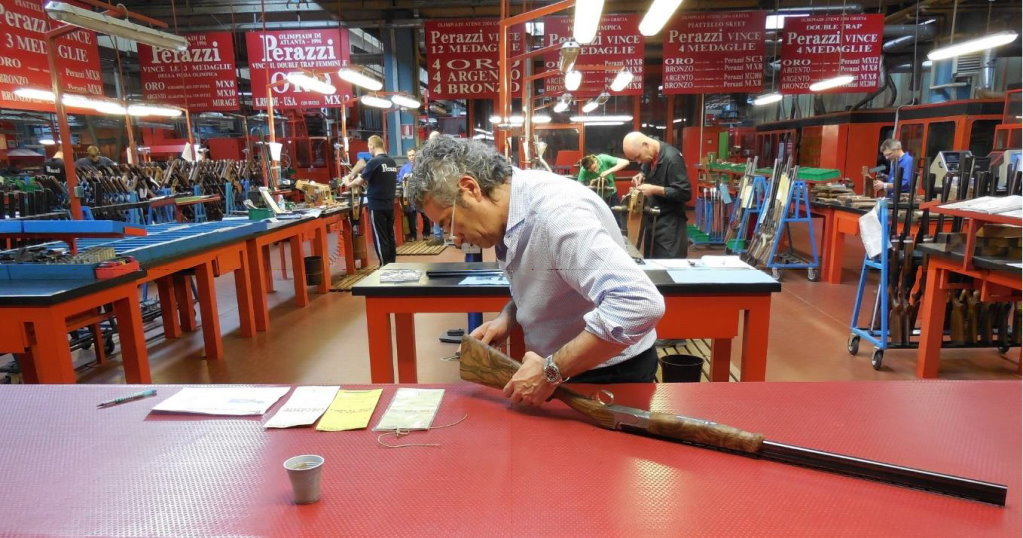
Mauro carefully checking the MX28’s stock measurements after a test firing.
We were back the following afternoon. Debra, who had often answered my telephone calls, was at the desk. MX28 was waiting, stocked to the finely-sanded stage, and ready for a tryout on the test-pattern plate. The bare walnut, now gracefully contoured, was alive with colour and contrast. Luca Candio had stocked the gun, and would later repeat the magic on MX28B. Roberto Zucchinelli would transform the remaining blank into a sideplates gunstock. Perazzi stockmakers are specialists in their respective fields.
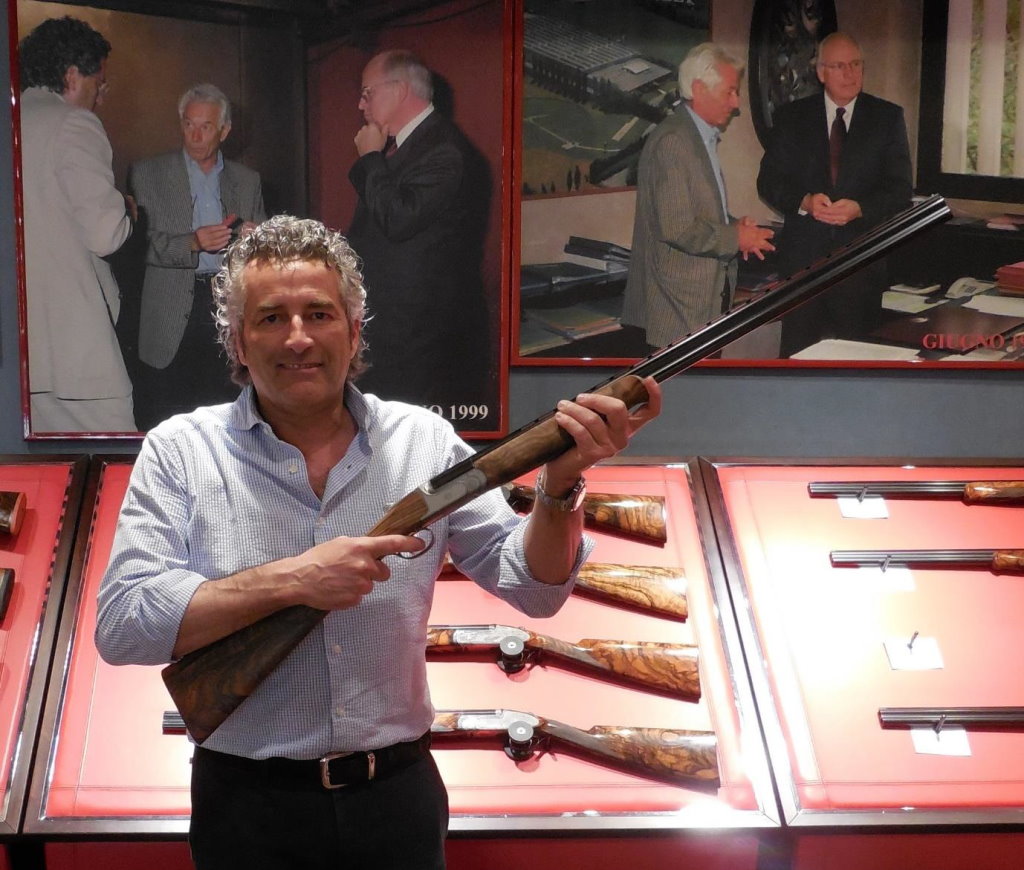
Mauro Perazzi proudly displays the MX28. “I’ll stand here,” he said, “with the pictures of my father in the background.”
MX28 fitted like a glove and, as with the try-gun, the test results had borne this out. I took my bag limit of pattern plates. Next came a highlight of the trip. Leigh hadn’t fired a solitary shot from any gun whatsoever for about 38 years (when we were kids, shooting with Dad’s .22). We coaxed him into having a shot. Mauro coached on holding the gun, and sight picture, etc. „Bang!“ Big mistake. Mauro and I exchanged glances. You can see the result in the photographs. Leigh thinks he’s a crack shot, Mauro thinks he makes great guns, and I think the pair are just plain lucky (for want of a better word).
We retired to the showroom and said our goodbyes. Roberta Perazzi took our group photograph, and we were off to Venice, Rome, and home.
Almost a year to the day that I had telephoned Bianca Revello, the trio arrived safely. The sideplated gun had soaked up the time; and not due solely to its decoration, although you do have to wait patiently for the artists. I asked Mauro Perazzi another question concerning the „raw“ guns. Mauro estimated that the construction of a Sideplates model – only the gun – involves about 40% more time or work than an equivalent (in level of finish) SCO grade gun. I had noted that my MX28 and MX28B were proof tested in 2012; and the sideplated gun, early the following year. Mauro’s information puts many factors into perspective. I would also suspect that very few MX28 SCO/Sideplates parts are held in inventory. By the way, a years‘ wait is nothing; I’ve waited much longer for lesser guns.
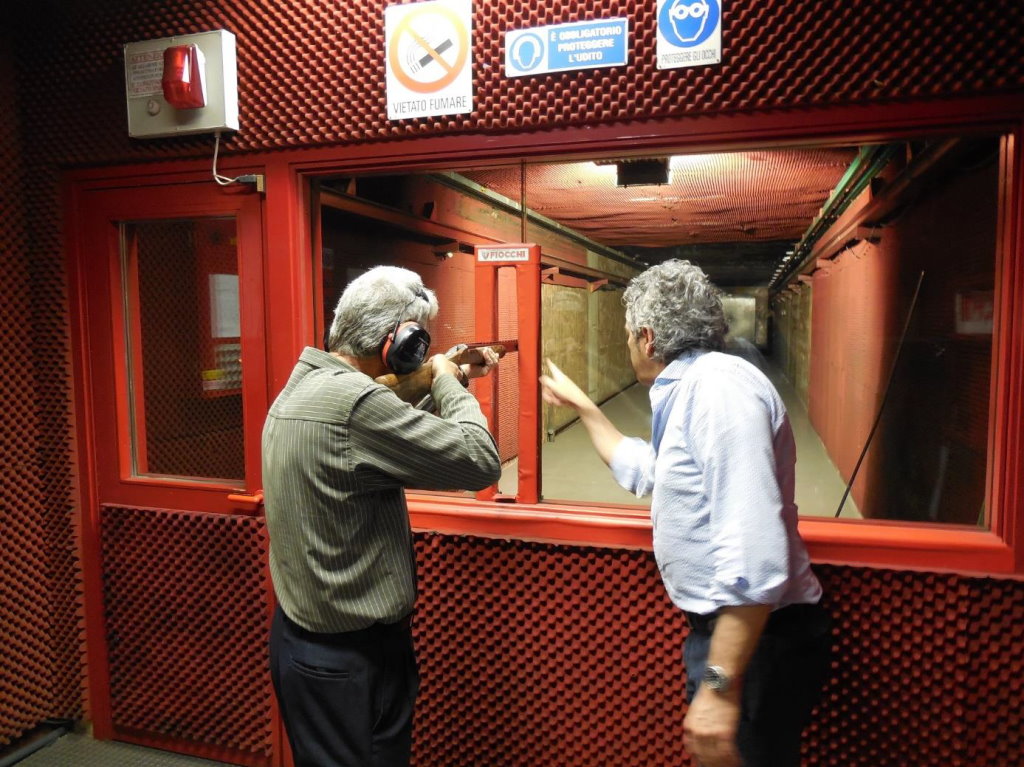
Leigh Przibilla firing his one and only shot for about 38 years. Mauro coaching … after coaxing.
Why Perazzi? First and foremost, I desired a great gun. Furthermore, Perazzi is here, and now … family, real people. I didn’t want to commission the building of a gun which is famous in „name“ only – a costly apparition from the past. Revered gunmakers have been acquired by investors and venture capitalists, or as a boutique curio for a major manufacturer. In 2009, Remington bought the Miller Arms trademark from Dakota Arms. The lineage was already tenuous. I have a rifle built on a Miller action from the personal inventory of Cyle Miller, son of the firm’s founder, the late Dean Miller. Mine is a genuine Miller, a „Miller Miller.“ Additional to the Perazzi guns‘ perfection, I invested in the Perazzi family’s passion and pride. Its value? Inestimable.
How to conclude my tale? Easy. Every aspect of my adventure – the people, the factory, and the guns – had exceeded my highest expectations. Leigh’s not a shooter, but he loved visiting
Perazzi. I had spent a fair amount of money and received the goods plus interest. I firmly believe that I ended up with the better part of the deal.
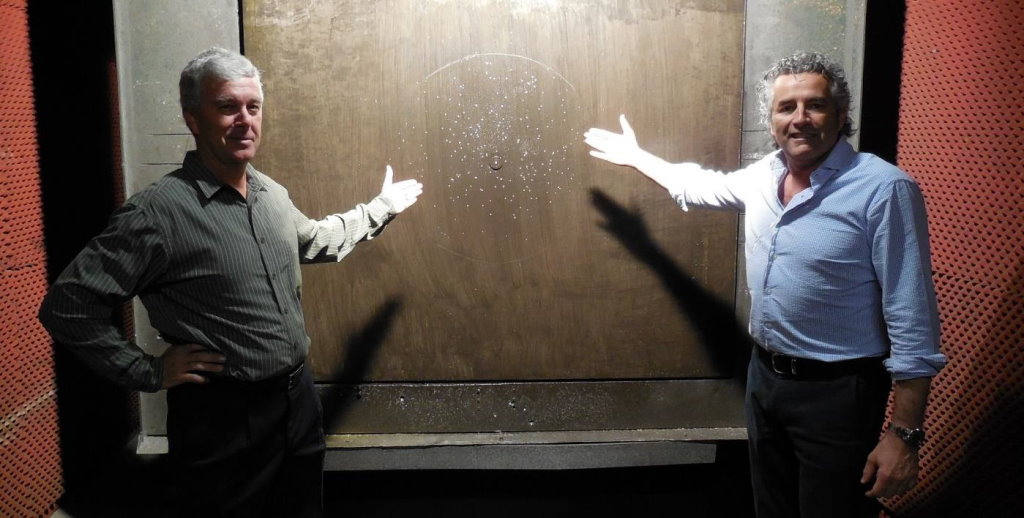
Cheshire cats! Leigh thinks he’s a crack shot. Mauro thinks he makes great guns. I think it’s ridiculous.
I wrote a thank you letter to Mauro, who replied, „We made every effort to produce the guns in the best way possible. We still have good workers. I am proud of all of them!“
So am I.
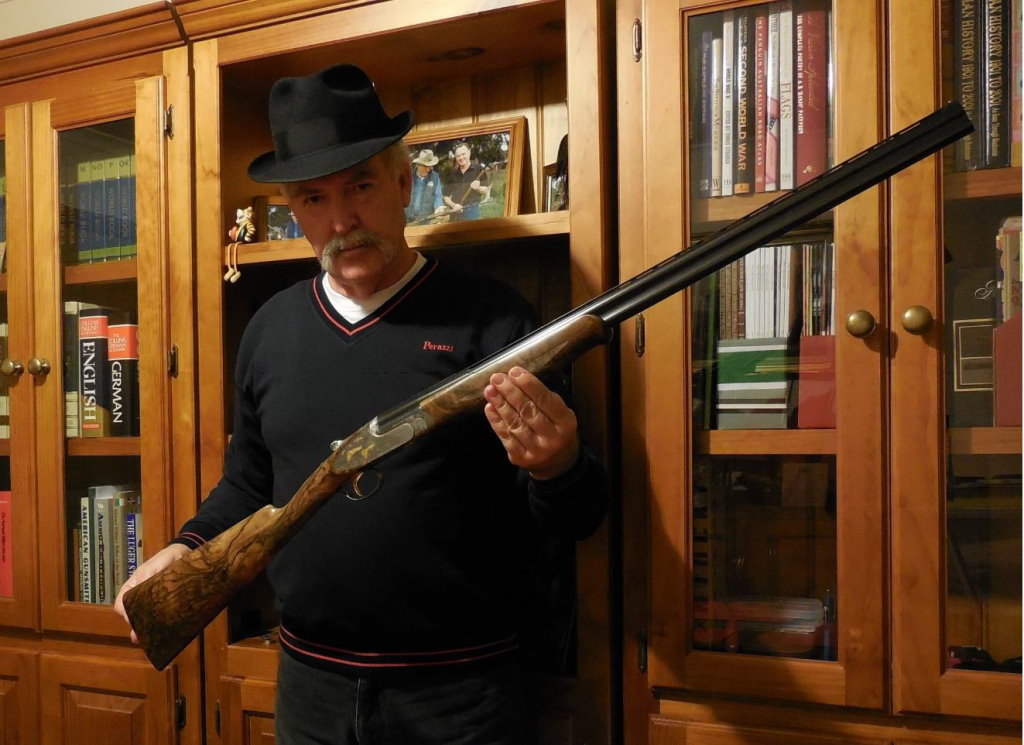
Safely home.
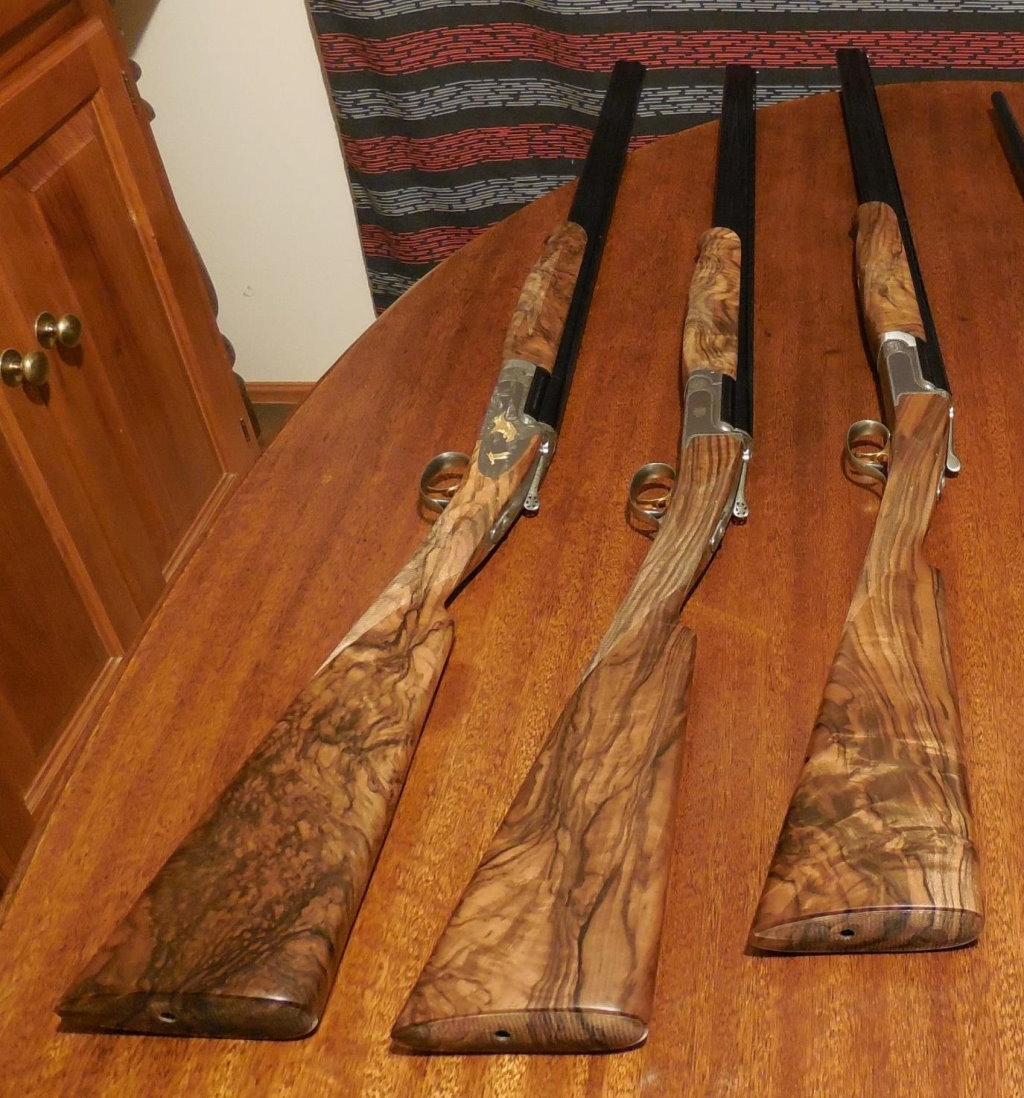
Although Perazzi’s revered competition guns are constantly, and deservedly, in the limelight, it’s the firm’s inconspicuous game guns which invariably wear the fancy duds.
ACKNOWLEDGEMENTS
Information and help from the following people made this article possible:
Mauro Perazzi, Bianca Revello, Filippo Petriella, Creative Art, Pavel Zeman, Steve Fjestad, Kathleen Attwood, Leigh Przibilla, Peter Rockliff, Keith McAuliffe, John Palermo and Pasquale Palermo.
BIBLIOGRAPHY
Karl C. Lippard, Perazzi Shotguns, Vietnam Marine Publications, USA, 1994.
E N D
Mauro Perazzi: “It’s the only one we’ve ever built that way.”
Perazzi factory showroom, April, 2013.
This article was originally published in GUNS&GAME magazine Number 81, January-March, 2014.
www.gunsgame.com © 2014 Gary J. Przibilla and Safari Publishing Co. Pty. Ltd.
Email. Publisher: gunsgame@gunsgame.com Author: mx28@outlook.com

